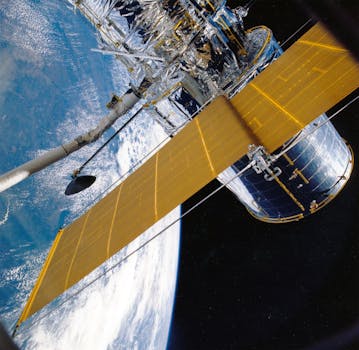The Future of Satellites: Revolutionizing Global Connectivity and Exploration

The Future of Satellites: Revolutionizing Global Connectivity and Exploration. The future of satellites holds immense promise for global connectivity, exploration, and innovation. With advancements in space technology, satellites are poised to revolutionize the way we communicate, navigate, and understand our planet. In recent years, there has been a significant increase in the number of satellite launches, with both government agencies and private companies investing heavily in satellite technology.
Satellites have been a crucial part of modern life for decades, providing essential services such as navigation, communication, and weather forecasting. However, the next generation of satellites is expected to be even more powerful and versatile, with capabilities such as high-speed internet, advanced Earth observation, and deep space exploration. One of the most significant developments in satellite technology is the emergence of satellite constellations, which involve launching hundreds or even thousands of small satellites into low Earth orbit to provide global coverage.
Section 1: Satellite Constellations
Satellite constellations have the potential to revolutionize the way we communicate and access information. Companies such as SpaceX, OneWeb, and Amazon are investing heavily in satellite constellations, with plans to launch thousands of satellites in the coming years. These constellations will provide high-speed internet access to remote and underserved communities, as well as enable new technologies such as autonomous vehicles and smart cities. However, the development of satellite constellations also raises concerns about space debris, radio frequency interference, and the environmental impact of launching large numbers of satellites.
Section 2: Advanced Earth Observation
Another significant area of development in satellite technology is advanced Earth observation. Satellites are being used to monitor climate change, track natural disasters, and predict weather patterns. The European Space Agency’s Copernicus program, for example, provides high-resolution images of the Earth’s surface, which are used to monitor deforestation, ocean health, and urban development. The NASA’s Landsat program is another example of advanced Earth observation, providing valuable data on land use, land cover, and natural resources.
Section 3: Deep Space Exploration
Satellites are also playing a crucial role in deep space exploration. NASA’s Artemis program, for example, aims to return humans to the lunar surface by 2024, with the ultimate goal of establishing a sustainable presence on the Moon. The European Space Agency’s JUICE mission, on the other hand, will explore Jupiter’s icy moons, which are believed to have the potential for hosting life. Satellites are also being used to study the outer reaches of the solar system, with missions such as the NASA’s Voyager program and the European Space Agency’s Cassini mission.
Section 4: Challenges and Opportunities
While the future of satellites holds immense promise, there are also significant challenges to be addressed. One of the major concerns is space debris, which poses a risk to operational satellites and increases the cost of launches. Another challenge is radio frequency interference, which can disrupt communication systems and impact satellite operations. Despite these challenges, the opportunities presented by satellite technology are vast, with potential applications in fields such as agriculture, healthcare, and finance.
Section 5: Conclusion
In conclusion, the future of satellites is bright, with advancements in space technology poised to revolutionize global connectivity, exploration, and innovation. As satellite technology continues to evolve, we can expect to see new and exciting applications in fields such as communication, navigation, and Earth observation. With the emergence of satellite constellations, advanced Earth observation, and deep space exploration, the possibilities are endless, and the future of satellites holds immense promise for humanity.

